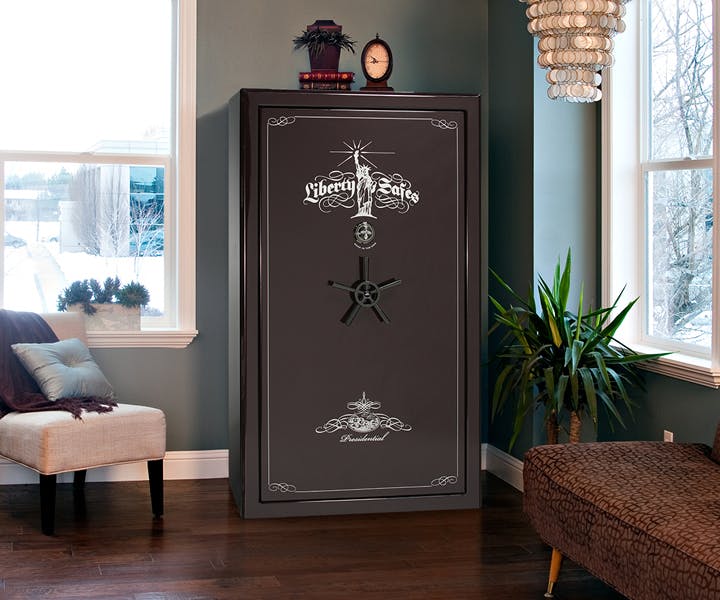
Personal protection is a priority everyone has in the back of their minds on a regular basis. Whether it is locking your doors when leaving for work during the day, or leaving on porch lights during the night, good habits can help you avoid the threat of forced entry and burglary. Crime in the last ten years has decreased greatly, and many hypotheses have been explored to find the cause; one of the most likely is the development of security technology. Security cameras, electronic locks, motion sensing lights, and more have deterred thousands of potential criminals from performing their illegal acts.
While all of these devices discourage thieves from entering your home, there are still those who would break in without regard for the consequences. A security camera is only as good as its ability to identify intruders, and motion-activated lights will only stop a burglar if someone is there to notice them. It is even worse if the burglar knows exactly what they intend to steal, as talented burglars can spend days scouting out potential targets. So what can you depend on to prevent an intruder from stealing some of your most treasured and vital possessions? Perhaps the final and most important line of defense available to you is a strong and dependable personal safe.
In centuries past, safes were nothing more than a wrought-iron box and a simple lock. Technology has brought the safe into a whole new age of protection, capable of not only keeping thieves at bay, but keeping your possessions safeguarded from fire, water, crushing weight, and even explosive force. The quality of safes can vary wildly, however, and it is important to do some homework on the safe you intend to purchase. You can think of a safe as an investment all on its own, especially if you are searching for a large safe or a gun safe for firearms and hunting hardware. Sometimes a safe isn’t just for keeping burglars out, after all: a dependable safe can also keep children and family members “safe” from finding objects and firearms they should not access.
Safes of All Sizes
No matter what you intend to protect, there is a perfect size safe for your needs. And for all of those sizes, you have many variations that you can select, from wall mounted safes to gun safes and even fireproof safes rated to protect the internal space of your safe from high temperatures. For all of these variations, however, there are pros and cons for each. The average time a burglar spends trying to open a safe during their trespass is five to seven minutes, just short of the amount of time spent during the average heist. Will your safe be able to withstand an assault for that time? Or can your safe avoid forced entry by being hidden?
Small Safes and Strongboxes
Perhaps the most common safe you will see for sale at retail stores is the small safe. These safes are very useful in storing important items like papers and photographs you might forget about otherwise. Fairly easy to conceal, these safes can fit under beds, in closets, and in other locations where the unaware would not think to look. The price of small safes depends on the type of protection you want: fireproofing, tool-resistance, and water-resistance can increase their value, especially if they are manufactured for these specific purposes.
Another positive aspect of choosing a small strongbox is their portability. If you need a tough container to protect your most important belongings while traveling, a small safe can fit into luggage, in the backseat of your van, or in the trunk of your car.
The main disadvantage to these safes is the same as their advantage. Due to their small size, if they are found by burglars, the whole safe can be stolen and pried open off-site. They are also not typically constructed to withstand the force of a drop from a great height, or explosive force. Whether any thief is daring enough to use these methods to force the door open and risk damaging the contents inside isn’t quite the point; burglars are usually pretty desperate. If the common thief saw a safe lying exposed for the taking, you can easily imagine the lengths they would go to access the “goods”.
Another disadvantage is their weight. A small safe might appear like a simple box, but the many layers of plastic, fire-retardant material, and metal can weigh quite a lot. While some can fit inside luggage, you may not want to lug it around with you for long lengths of time. Consider keeping it locked inside your vehicle and concealed, or keep it inside your hotel room as an extra precaution. If you visit hotels, speak with your hotel manager; good chances are they can hold onto it for you during your stay for a small fee or they have a safe in your room where you can store your valuables.
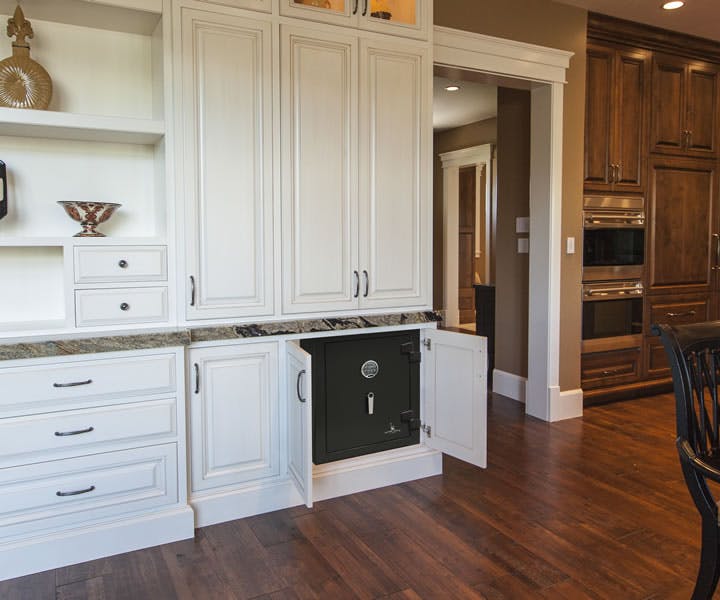
Wall and Floor Safes
You might think hiding a safe behind a cleverly-hung painting is something only done in movies, but it may surprise you that wall safes are very popular with homeowners and can actually be hidden in many creative ways! Installed in between the studs of a wall and screwed into said studs, your chosen wall safe will become a permanent part of your home. Many sizes are available online, which is probably your best bet for finding a high-quality safe that you can also afford. Perfect inside closets, behind furniture, or even out in the open, they can be installed in such a way that crowbars cannot have the proper angle to pry them open. The sole fact that they cannot be stolen like a portable personal safe makes them invaluable for businesses or home offices.
Along the same lines are floor safes. Installed either in between the floor and ceiling of a multi-story building or anchored into the cement of a new home, an installed floor home safe is one that cannot be moved. Again, these safes come in many sizes to fit your belongings, although the depth of these safes are usually kept more shallow than a large safe to make them more accessible. Placed in a garage or basement, they make great places to store expensive tools or firearms in between hunting seasons.
Wall safes are a great option so long as they are built to withstand heat. If your house catches fire, the safe is going to be stuck in between the studs of your home until they deteriorate or are extinguished. Floor safes, on the other hand, will usually be okay from fire if they are installed in cement. The only issue you need to be concerned about with floor safes is flooding. Most safes are water-resistant, but not waterproof; unless built specifically for the purpose, water may leak in and ruin anything within, especially in deep water or given enough time.
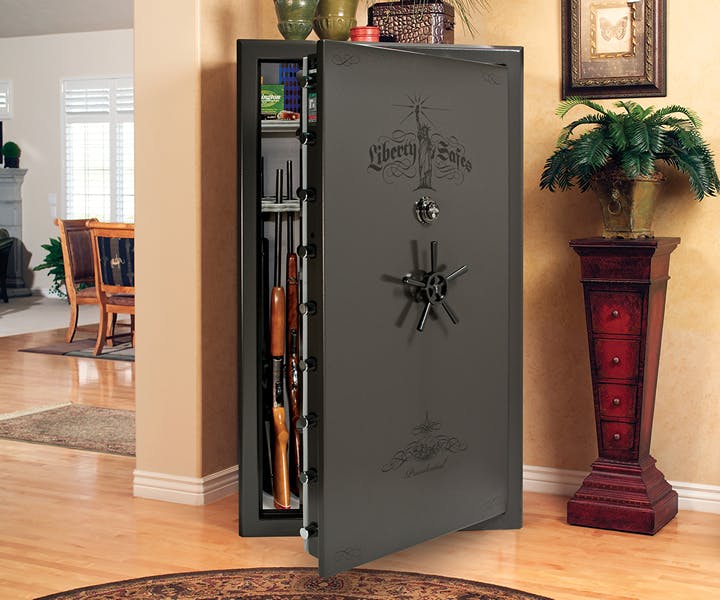
Gun Safes and Gun Cabinets
Guns are dangerous tools in the hands of those who are unfit or untrained in their use. You definitely wouldn’t want your child to play with guns and you also don’t want a burglar to be able to use your own weapon(s) against you. Securing your weapons and all the equipment you use for their maintenance should be a huge priority for any gun owner. Specifically designed to hold firearms, a gun safe comes equipped with (or is large enough to fit) pistol racks, hooks for hanging rifles, door pockets for accessories like scopes and ammunition crafting hardware, and may come with a separate lockable compartment for ammunition. A gun cabinet is similar, and although it has lockable drawers, they are more for showing off your collection since they are built with large clear windows.
There are two points we should make regarding gun safes and their use. First, never store a loaded gun. When replacing your firearm inside your safe, remove your clip and empty the chamber completely. You may think a loaded gun will help you be instantly prepared during a home invasion, but think what would happen if your child found your gun and decided (as any child might) to shoot the gun without any thought of the consequences. Too many tragedies have occurred due to this rule not being followed.
The second point is much like the first: store your ammunition in a different place than your guns. A gun with ammunition is a lethal weapon and although you don’t want to leave your ammunition in your gun while it’s stored, you do want to make sure you have ammo and that it is safely stored. A gun without ammunition is merely a heavy piece of steel, and a bullet without a gun is a useless piece of brass and lead. As guns are some of the most valuable items to steal, keeping them secure is a very good idea. Imagine what would happen if a burglar invaded your home with a knife only to find your guns and ammo; suddenly your home invasion has become a very deadly hostage situation.
You may think to yourself, “Wouldn’t these two rules make it difficult to stop an intruder?” In theory, yes. But it isn’t like you should store your gun and your ammo on opposite sides of your home. In practice, if you have a dependable gun safe or gun cabinet with separate lockable compartments, you will have what you need in the blink of an eye without putting yourself or your family at risk.
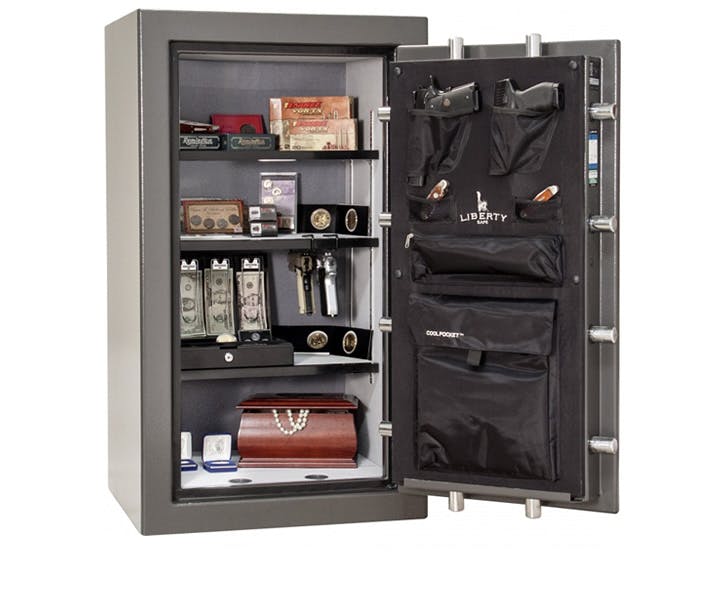
Large Safes and Jewelry Safes
If you need maximum protection and a ton of space, you’ll want to purchase a large security safe. A large-capacity high-quality safe is a behemoth of a vault, weighing anywhere between 250-1250 pounds depending on the manufacturer and overall volume. The right security safe of this size is solid steel construction, and can withstand a serious amount of punishment from fire, water, explosives, cutting tool force, and, of course, the common crowbar. Whatever the average home needs protected can be placed inside secure storage, from heirlooms and jewelry to important documents and currency (more on that later). The jewelry safe in particular can have a lot of accessories that keep necklaces, bracelets, cufflinks, and earrings in mint condition. A jewelry safe is not just a high school locker. With interior lighting, velvet padding, a drawer for small valuables and jewelry boxes, and even watch winders to keep precision timepieces running smoothly, these safes are made for luxury.
The one precaution you should take with a large home safe is to bolt it to your floor or wall. A team of thieves can make quick work of safes simply by dropping them on their backs and using their individual body weight upon crowbars to pry the safe wide open. In the five-to-seven minute span of break-in time, you would be surprised at how many large safes cannot stand up (literally) to the intense force of determined burglars.
Many of these safes also feature concealed hinges. Concealed hinges are built into the interior of the security safe and don’t provide burglars access for cutting tools like saws and plasma torches.
Fireproof Safe Specifications
Safes are not simple steel construction. Between the steel is ceramic or fiberglass that guards the interior..Every dependable fireproof safe is rated by an agency called Underwriter’s Laboratories (or UL) for heat resistance for a set amount of time. For example, a UL 350 one-hour safe is one that will keep internal temperatures below 350° F for an hour even when being subjected to an external temperature of over 1700° F. As the average house fire varies between 1000° F and 2000° F, this type of fireproofing is very acceptable to protect your valuables.
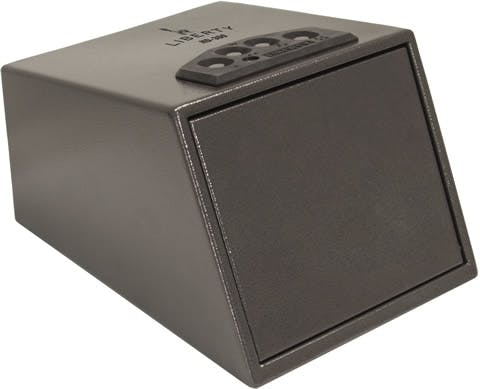
Types of Modern Locks
Safes have different types of locks. Think of the locks you see on a regular basis. Your front door’s lock, a padlock, a combination lock, an electronic keypad. Even your phone has a lock. Locks come in all sorts of shapes and sizes, and all of these are applicable to safes. Just like safes, there are advantages and disadvantages to different lock types. Some safes will only have a single lock, while others may have two or three.
Keys and Keyholes
The humble key and key lock has protected belongings for hundreds of years. A padlock is pretty straightforward, although containers with padlocks aren’t exactly safes (a more appropriate term would be, a lock box). A built-in tumbler lock relies on miniature metal rods that fit the ridges of the key as it slides into place, enabling the locking mechanism to turn and open. These locks rotate a piece of metal to unlock the front from the frame, or enable a lever to be pulled to do the same. Many safes have this lock type as a backup in case electronics run out of power or codes are forgotten.
Because of easy access to lockpicks, a keyed safe is one of the less secure types of locks unless the strong security safe has been built with lock resistance in mind. Keys can also be lost, of course, so be sure to keep your key in a place you will remember, but not so visible that burglars can find it and use it. If your gun safe relies on a lock, ensure that children will not be able to access your safe’s contents by finding the key.
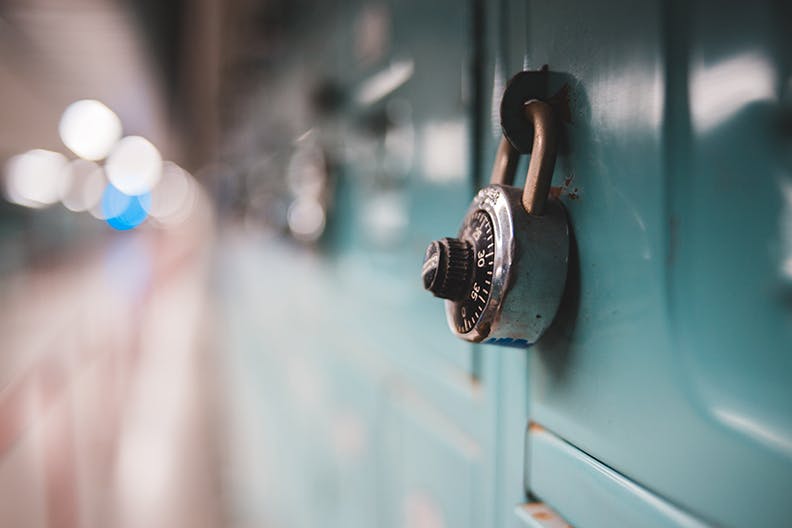
Combination Locks
If you have ever stored books or gym clothes inside a locker before, there are good chances you have come across one of these locks before. A combination lock works a bit like a tumbler lock, but instead of a key lock, you have a rotating dial with dozens of numbers that align tumblers with each correct number. These locks are very dependable, although they can be a bit tricky to use with a smaller security safe.
Electronic Keypads
Even simpler to use than a key, an electronic lock utilizes a keypad much like your smartphone lock. Memorize your code, and you will have instant access. Often running on batteries, you will not have to worry about your digital keypad being unusable during power outages or disasters. The safe will also warn you when batteries are about to run out. If the battery does indeed die, safes featuring an electronic lock will have an alternate method of opening your safe, usually a lock and backup key you should store for safekeeping.
Biometric Locks
A very modern lock is one you would expect more from your smartphone than your safe. A [biometric lock](“https://www.covesmart.com/blog/biometrics-a-guide-to-biometric-security “) is one that records your unique fingerprint and opens only to your fingerprint. Biometric safes are great personal safes. Some of these safes can even register multiple fingerprints to grant others access.
Timed Locks
If you have ever worked retail, you may be quite familiar with these types of safe locks. A timed lock is a device that enables the safe to only open during certain times of the day. The purpose of these locks may seem a bit unintuitive. Largely used to contain large amounts of money needed to perform regular business, a timed lock typically gives a manager the appropriate amount of time to supply tills and perform deliveries to a local bank at the beginning of the day. And once the store closes, the safe will hold the profits until the next morning for the next morning’s delivery.
These types of locks are built not only to keep burglars from breaking in during off-hours, but also to enable owners to protect their assets from employees or family members when they are not present, even if they know the lock code. Even if you are not a business owner, timed locks are a great option if you have objects that you only want accessed at certain times of day and kept sealed until the time passes again. Similar to other electronic locks, timed locks run either on your home or business’s power grid and/or with batteries that will enable it to function during power outages.
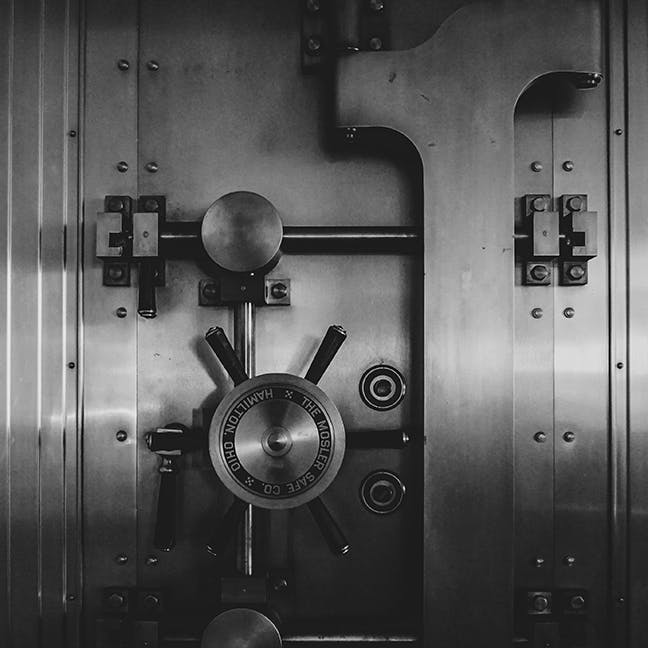
Unique Features of Safe Locks
Locks are rarely simple these days. You may think a lock is simply a small piece of metal on the interior that prevents the safe from opening. But many safe doors offer better protection, especially for larger personal safes. Safe doors on large safes often come equipped with hardware that seals the door shut with the strength of three, four, or five solid steel cylinders. These bars emerge and retract from the side of the front into the frame of the safe and can range in thickness from .5” inches to 2.5” inches, or more depending on the size of the safe. For vault-sized safes, these bars can also extend all the way from the bottom to top of the door, providing a complete seal.
This may sound impressive on its own, but one manufacturer has made an improvement on top of this. Liberty Safe’s safes feature a length of military-grade steel, connecting the door to the frame of the safe with wide, flat bars instead of solid steel cylinders. This increases the surface area of the locks from three, four, or five single-inch points to several inches per bar from the top to the bottom of the door. This provides as much protection on the opening end of the safe as the hinge side. This nearly guarantees that even a team of talented criminals armed with crowbars will give up long before the safe does. Find out more about what Liberty Safe can offer you by visiting their website at LibertySafe.com.
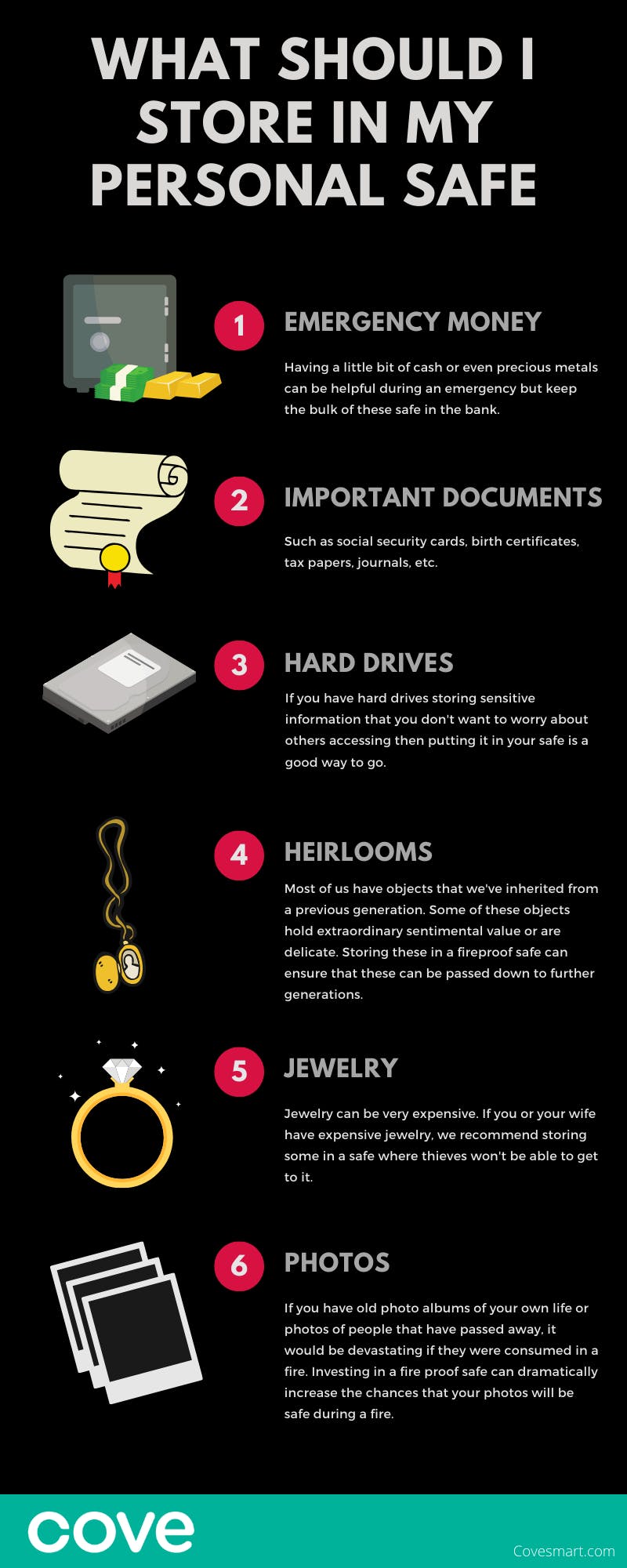
What to Protect, What to Store
A safe wasn’t given a name without reason: protection is the name of the game, be it from theft or damage. So what do you secure inside a safe? Instead of stuffing everything you own that’s valuable in one place (which burglars really hope you do), use a safe as an added barrier of insurance for the things that matter most. And most of all, use each safe according to their advantages. For example, a portable personal safe should not be full of cash and jewelry, and a floor safe should not hold unprotected books and photographs due to their water damage potential.
Here are a few items you can consider securing in an appropriate safe.
Cash and Currency
A safe will provide plenty more protection for your finances than stuffing your mattress with dollar bills!A rainy day fund is always a good idea, especially if that rainy day literally comes true. During natural disasters like earthquakes and hurricanes when local banks and credit unions are unavailable, having a bit of cash or emergency credit cards on hand can help you survive while evacuating. If you have a prepper mindset, having cash or at least some form of payment on hand (silver and gold, for example) can help you barter for supplies if the worst ever comes to pass.
We do not recommend storing large amounts of money or precious metals inside a safe, however, as these can be safely stored and insured at banks and financial institutions. You do not want to have all of your eggs in the same basket, because giving a burglar a single huge target is like offering them a payday should they break in. It can also make you a target if someone acquires information on your safe’s contents. For this reason, even if you own a high quality safe don’t have all of your valuables stored in one place.
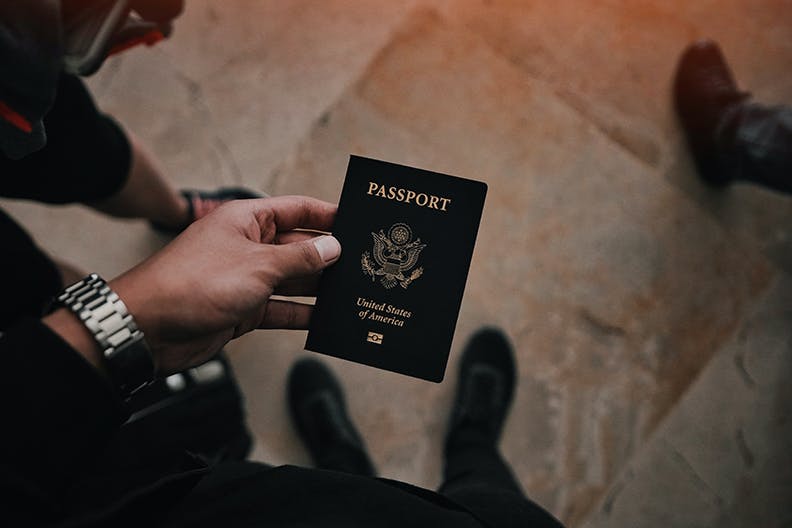
Important Documents and Hard Drives
During a natural disaster, frantically scouring your home for documents like birth certificates, social security cards and tax papers is the last thing you want to do. You have a family to protect! Keep these important documents together with a wall safe or concealable strongbox somewhere in your home. Guarding these items inside a safe is important for several reasons, though two main reasons come to mind.
First, a safe will protect your important documents from theft; identity theft is already a terrible problem in the modern world, but just imagine what a thief could do with your authentic documents and financial papers.
Second is to give you a central location to store everything should a disaster strike your home or your local area. A fireproof-rated safe can keep these papers from going up in smoke in a fire. The video below demonstrates how effective a fireproof safe can be. Large or installed safes can keep these documents safe from major weather events, even if the structure of your home or business collapses.
Another good use for safes is to protect hard drives. Much of the identity theft performed today is done online by accessing data remotely, either through direct access, phishing scams, or with viruses and malware. By unplugging your data and removing it from the network entirely, you guard your information in the best possible way. It is important to note, however, that hard drives do not fare well in high temperatures (even less than paper, in some cases), nor do they take very kindly to blunt force. If you plan to store hard drives in a safe, it may be wise to consult your safe’s manufacturer on the best location to install your safe in your home or office for this purpose.

Heirlooms and Jewelry
Besides the obvious use of keeping thieves away from your most precious valuables, storing invaluable family treasures and jewelry inside a reliable safe can protect them from disasters. You may not think fire can damage precious metals, but you might be surprised at the amount of deterioration and tarnishing possible under high temperatures; the melting point of gold, for example, is 1900° F, which is very possible in an intense house fire.
A safe is also a perfect location to help you remember where your valuables are stored and protected. Losing those important inherited pieces can be a tragedy all on its own.
Photographs, Books, and Film Reels
While burglars may not be targeting them, safes can protect all of the memories you hold dear. Photographs (especially negatives and slides) are very susceptible to heat and high humidity, and a safe equipped with a dehumidifier can preserve prints and art. First edition books are also vulnerable, as are film reels and microfilm reels. The average home may not have items like this, but you can see how effective safes can be in protecting even the most delicate of objects.
In addition to having a safe, having a home security system can prevent burglars and ne-er-do-wells from even getting close to your safe. Cove has one of the most effective and affordable security systems around so check us out at our home page.
